Lynn Austin's Blog, page 25
May 9, 2013
Small Miracles
I have a story to tell about one of God’s small miracles. A true story. If I made it part of the plot of a novel, the “coincidence” would be unbelievable.
 Last Christmas, I attended a concert at Moody Church in downtown Chicago with two couples from our Bible study group. My husband Ken performed in the concert. Before the music started, I was talking with my friend Peggy about the pain she still experienced from a car accident a few years ago. I mentioned that my 85 year-old mother, who has a quiet, one-woman prayer ministry, had been praying for her.
Last Christmas, I attended a concert at Moody Church in downtown Chicago with two couples from our Bible study group. My husband Ken performed in the concert. Before the music started, I was talking with my friend Peggy about the pain she still experienced from a car accident a few years ago. I mentioned that my 85 year-old mother, who has a quiet, one-woman prayer ministry, had been praying for her.
A stranger seated in front of me suddenly turned around and said, “Would your mother please pray for me, too?” He told me his name was Shad—short for Shadrach—and he explained how he was also in great pain and had trouble sleeping at night. “What’s your mother’s name?” he asked. “If she’ll pray for me, I’ll pray for her.” We exchanged information, the concert began, and Shad and I didn’t talk again.
Every morning, my mother (who lives 800 miles away from me) faithfully prays for her daughters, sons-in-law, twelve grandchildren and their spouses, and her eleven great-grandchildren—along with countless other people she hears about, like my friend Peggy. She added Shad to her list. In fact, she told me that he often came to her mind—sometimes in the night—and she prayed for him then. Most of Mom’s prayers are answered in amazing ways, but there have been some prayers that have gone unanswered for a long, long time. She rarely asks for prayer for herself, but I knew of one particular need in her life that she was trusting God to answer—and He just didn’t seem to be listening.
Four months after the Christmas concert, I returned to Moody Church with two friends on Easter Sunday to hear my husband play for their morning service—a glorious musical experience that always makes me feel like I’m in heaven, listening to the angels sing. When Mom heard that I would be returning to Moody she said, “Oh, maybe you’ll see Shad again. Find out how he’s doing. I think of him so often when I pray.”
“Impossible!” I told her. “Finding him would be like finding a needle in a haystack!”
For one thing, I couldn’t even remember what he looked like, since he sat in front of me the last time. And for another, the auditorium at Moody holds close to 4,000 people and every seat is filled on Easter. I found it impossible to imagine that I would cross paths with Shad again, especially since I would be sitting in a completely different part of the auditorium this time. But for Mom’s sake, I did look around half-heartedly that morning, eyeing the nametags that ushers and some church members wore, looking for one that said “Shad.” My friend asked me who I was searching for and I told her the story. She agreed it would be nearly impossible to find a man whose face I couldn’t recall. I didn’t even pray that God would help me find him because I didn’t really believe He would answer such a difficult prayer.
A few minutes before the service started, I happened to overhear a conversation behind me, just as Shad had overheard mine at Christmas. The two men who were talking had never met, so they introduced themselves. One of them said, “Nice to meet you. My name is Shad—short for Shadrach.”
No! Impossible! Right behind me?
I whirled around with tears in my eyes and reminded Shad how we had met at Christmas. He told me that my mother’s prayers were being answered. I marveled at how God had put him right behind me in an audience of nearly 4,000 people and he said, “You know, I started to sit farther back, but I heard the Lord telling me to move up. And there was only one empty seat—right behind you.”
I couldn’t wait to call Mom and tell her the story. Finding Shad was indeed a miracle, but I believe the even bigger miracle was that God would orchestrate this impossible reunion just to encourage His faithful, sometimes discouraged, prayer warrior. He wanted to let Mom know in a personal, seemingly impossible way that He loved her and was listening to her every word when she prays. He truly did hear all of her prayers, even the unanswered ones.
But this Easter miracle was meant for me, as well. I have no trouble believing in God’s big miracles like the Christmas story and the empty tomb—I was praising Him that morning for the miracle of His resurrection from the dead. But for the small things in my life? Surely God was too busy to micro-manage the little details. I have a few unanswered prayers of my own that I’ve been praying about for a long, long time. But when I consider the size of the crowd filling the auditorium—and overflowing into a second hall with a video screen—I can’t deny that He performed a miracle that Resurrection Sunday. Only He could put the very stranger I was searching for in the seat right behind mine.
My prayer time has been re-energized by my “chance” meeting with Shad. And I’ll continue to pray for all of the impossible, unanswered needs on my list. Because the God who is listening is a God of small miracles as well as big ones.
What are some of the small, seemingly impossible ways you’ve seen God work in your life?
April 15, 2013
Playing, Writing…and Playing
I enjoyed Robin Lee Hatcher’s blog last week about how much she loved to read as a child, and I envy her early discovery of the joy of writing. But I have a confession to make. While I also grew up in a household of readers—my mother was the town librarian—I was never a reader as a child. And I couldn’t sit still long enough to write! I remember my third grade teacher reading one of my writing assignments aloud to the entire class and praising it—my first 5-star review—but I still didn’t catch the writing bug.
 I loved books when someone else read them to me. This is a picture of my sister Bonnie reading to me when she was 5 and I was 3. I also loved listening to my mother read bedtime story classics like Uncle Wiggly and Charlotte’s Web. My grandmother was a natural-born storyteller who could keep me spell-bound for hours on warm summer evenings with tales from her childhood. But I didn’t want to read or write in my spare time—I wanted to play, living out all the wild stories in my imagination. I had neither the time nor the patience to sit still with a book when I could be a character from Treasure Island or from a story I created. I lived in the world of my imagination like the little boy in the cartoon “Calvin and Hobbes.” That stuffed tiger was real, even if no one else could see it. My bicycle was a real horse and I galloped down the street with the wind in my face, my pigtails flying.
I loved books when someone else read them to me. This is a picture of my sister Bonnie reading to me when she was 5 and I was 3. I also loved listening to my mother read bedtime story classics like Uncle Wiggly and Charlotte’s Web. My grandmother was a natural-born storyteller who could keep me spell-bound for hours on warm summer evenings with tales from her childhood. But I didn’t want to read or write in my spare time—I wanted to play, living out all the wild stories in my imagination. I had neither the time nor the patience to sit still with a book when I could be a character from Treasure Island or from a story I created. I lived in the world of my imagination like the little boy in the cartoon “Calvin and Hobbes.” That stuffed tiger was real, even if no one else could see it. My bicycle was a real horse and I galloped down the street with the wind in my face, my pigtails flying.
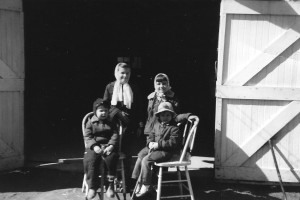 I created elaborate stories for my sisters and friends with plots and story lines that lasted for days. We were cowboys and Indians. We were pioneers who made great, epic journeys in our red-flyer “Conestoga” wagons packed with our baby dolls and food supplies. The fields and woods near our house were vast, uncharted wildernesses where we might encounter pirates or find buried treasure. We camped out in makeshift tents in our backyard during the summer, imagining that we were great explorers on safari. The dark, creepy cellar of our 100 year-old house became the setting for many spine-tingling mysteries. Here is a picture of my two sisters and me with a friend, pretending to be a pitiful family of orphans like The Boxcar Children.
I created elaborate stories for my sisters and friends with plots and story lines that lasted for days. We were cowboys and Indians. We were pioneers who made great, epic journeys in our red-flyer “Conestoga” wagons packed with our baby dolls and food supplies. The fields and woods near our house were vast, uncharted wildernesses where we might encounter pirates or find buried treasure. We camped out in makeshift tents in our backyard during the summer, imagining that we were great explorers on safari. The dark, creepy cellar of our 100 year-old house became the setting for many spine-tingling mysteries. Here is a picture of my two sisters and me with a friend, pretending to be a pitiful family of orphans like The Boxcar Children.
The only writing I did besides school assignments was a play entitled “My Old Kentucky Home.” We performed it in our backyard and charged the neighborhood kids 5 cents each to watch—my first writing income. I barely remember the plot but as the production’s “security chief,” it was my job to protect our backyard theater from spies until the performance. I took my job very seriously and decided to stage a drill to keep everyone on their toes, making up an outrageous story about seeing a man in a yellow shirt skulking around. Unfortunately, my story was so convincing that it caused panic in our neighborhood as rumors of a mysterious stranger spread. How could I explain to all the concerned adults that there was a huge difference in my mind between telling a lie and using my imagination? One thing was clear, my early “fiction” was very convincing.
I didn’t discover that I enjoyed writing until I was in my thirties—and then it was like coming home, returning to my childhood, living in my imagination all over again. I loved it! Once again, I could live all sorts of adventures by putting myself in my characters’ shoes, making up stories, creating new worlds. Researching my historical novels is one of my favorite parts of this writing life. I love visiting the places where my characters lived, seeing what they saw and smelled and touched. By “playing” in all of these places, my imagination is set free to create.

Ellis Island
I played on Ellis Island for a day with my sister Peggy before writing Until We Reach Home, imagining what it was like to arrive there together like the immigrant sisters in my novel.
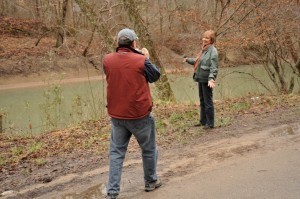 My husband and I played in the mountains of Eastern Kentucky when I researched Wonderland Creek, taking photos and notes along the way, letting the sights and smells bring the true story of the “Packhorse Librarians” to life.
My husband and I played in the mountains of Eastern Kentucky when I researched Wonderland Creek, taking photos and notes along the way, letting the sights and smells bring the true story of the “Packhorse Librarians” to life.
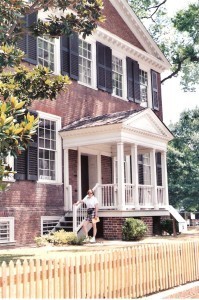 Candle in the Darkness took place in Virginia during the Civil War, so of course I had to spend time playing in a period bed-and-breakfast to get a feel for the elegance of Southern life.
Candle in the Darkness took place in Virginia during the Civil War, so of course I had to spend time playing in a period bed-and-breakfast to get a feel for the elegance of Southern life.
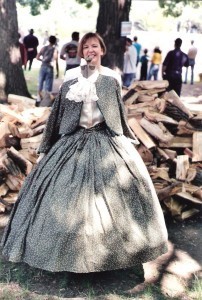 Researching Fire by Night took me to several Civil War re-enactments where I played all day, seeing what daily life in an army camp was like. (Wool uniforms are hot and hardtack tastes terrible!)
Researching Fire by Night took me to several Civil War re-enactments where I played all day, seeing what daily life in an army camp was like. (Wool uniforms are hot and hardtack tastes terrible!)
 For A Light to my Path, I took a hike into the wilds of a state wildlife refuge in South Carolina because I wanted to experience what an escaping slave might have endured. (Mosquitoes, swamps, alligators, and spiders the size of my hand!)
For A Light to my Path, I took a hike into the wilds of a state wildlife refuge in South Carolina because I wanted to experience what an escaping slave might have endured. (Mosquitoes, swamps, alligators, and spiders the size of my hand!)
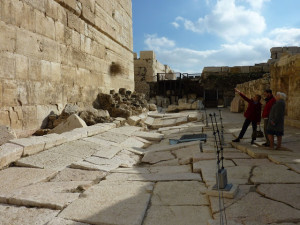 The book I’m currently writing, Return to Me, takes place in Jerusalem during the time of Ezra and Nehemiah—so of course I had to go to Israel to play. I ate Israeli food, walked along dusty hiking trails in the Judean countryside, worshiped at a remnant of the temple, and listened to Jewish songs and prayers. I needed to know what the birds sounded like in the morning and what the sky looks like above Jerusalem.
The book I’m currently writing, Return to Me, takes place in Jerusalem during the time of Ezra and Nehemiah—so of course I had to go to Israel to play. I ate Israeli food, walked along dusty hiking trails in the Judean countryside, worshiped at a remnant of the temple, and listened to Jewish songs and prayers. I needed to know what the birds sounded like in the morning and what the sky looks like above Jerusalem.
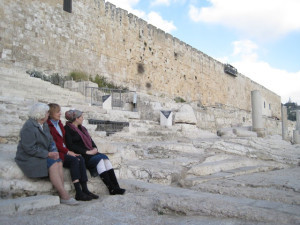 When I’m writing, I live in my imagination like I did as a child, creating stories that will take my readers to faraway places and times. Writing is play for me (and of course, it’s also very hard work!) But the adults don’t yell at me any more for telling “lies”—now I get paid to do it.
When I’m writing, I live in my imagination like I did as a child, creating stories that will take my readers to faraway places and times. Writing is play for me (and of course, it’s also very hard work!) But the adults don’t yell at me any more for telling “lies”—now I get paid to do it.
Best of all, I get to share my faith, incorporating the lessons God is teaching me into the lives of my characters. I wouldn’t trade my life for any other!
So tell me, how did you play as a child? And how might you bring the joy and creativity of your playtime into your life and your work?
April 1, 2013
Artist’s Date
 One thing I’ve learned during my 28 years of writing is that creativity is not infinite. Each time I sit down to dream up imaginary characters and the vivid worlds they inhabit, I’m tapping into a source that resembles a bucket more than a bottomless well or a flowing stream. If I don’t take time to refill that bucket, sooner or later my creative “juices” are going to run dry. Julia Cameron first drew my attention to the need to replenish my creativity in her book The Artist’s Way, and she taught me several ways to do it. She calls one of her ideas an Artist’s Date. This is time away from writing when I take my creative child somewhere to play. Last week, when writing became a chore and my nagging, inner critic started telling me that every word I wrote was drivel, I decided I needed to refill my empty bucket.
One thing I’ve learned during my 28 years of writing is that creativity is not infinite. Each time I sit down to dream up imaginary characters and the vivid worlds they inhabit, I’m tapping into a source that resembles a bucket more than a bottomless well or a flowing stream. If I don’t take time to refill that bucket, sooner or later my creative “juices” are going to run dry. Julia Cameron first drew my attention to the need to replenish my creativity in her book The Artist’s Way, and she taught me several ways to do it. She calls one of her ideas an Artist’s Date. This is time away from writing when I take my creative child somewhere to play. Last week, when writing became a chore and my nagging, inner critic started telling me that every word I wrote was drivel, I decided I needed to refill my empty bucket.
How I spend my artist’s dates varies. It has taken time—and trial and error—to discover what invigorates me and gets me writing freely again. I’ve learned that I’m always energized by feasting on the fruit of someone else’s creativity, so a trip to the Chicago Art Institute or even an afternoon with a cup of tea and one of my favorite art books is enough to get me going again. So is attending a concert or taking time to relax and listen to a Beethoven concerto. I’m married to a symphony musician so I get to fill up with a lot of great concerts. But since nature is one of my very favorite creative muses, I decided to spend my artist’s date at the Chicago Botanic Gardens.
 I know the calendar says April but Chicago is still gripped by a spell of blustery winter weather and 30 degree temperatures that just won’t quit. But even the frozen landscapes began to rejuvenate me as soon as I arrived at the 385-acre garden site, spread out over nine islands and surrounded by lakes.
I know the calendar says April but Chicago is still gripped by a spell of blustery winter weather and 30 degree temperatures that just won’t quit. But even the frozen landscapes began to rejuvenate me as soon as I arrived at the 385-acre garden site, spread out over nine islands and surrounded by lakes.
And when I entered the first of three large greenhouses, my tired soul and weary mind sighed, “Ahhhh….”
 The first thing that hit me was the fragrance! Wow! I wish I could add a scratch-and-sniff sticker that would transfer the aroma through this blog but technology hasn’t advanced quite that far, yet. The flowering jasmine was in bloom as well as the gardenia bushes. Did Eden smell this sweet? Along with the wonderful aroma, I was struck by the blessed warmth of a summer day. I shrugged off my coat—and would have kicked off my boots and socks to go barefoot if there weren’t other visitors. I inhaled the pure, clean air and silently thanked my new plant “friends” for creating all that fresh oxygen. It went straight to my brain, cleaning out the cobwebs. What a glorious dose of green—my favorite color.
The first thing that hit me was the fragrance! Wow! I wish I could add a scratch-and-sniff sticker that would transfer the aroma through this blog but technology hasn’t advanced quite that far, yet. The flowering jasmine was in bloom as well as the gardenia bushes. Did Eden smell this sweet? Along with the wonderful aroma, I was struck by the blessed warmth of a summer day. I shrugged off my coat—and would have kicked off my boots and socks to go barefoot if there weren’t other visitors. I inhaled the pure, clean air and silently thanked my new plant “friends” for creating all that fresh oxygen. It went straight to my brain, cleaning out the cobwebs. What a glorious dose of green—my favorite color.
 Feasting on the creativity of Beethoven or Van Gogh is wonderful but this was a banquet of God’s infinite creativity. A flower is a flower, right? Hardly! They came in so many sizes and shapes and colors that it was overwhelming. Every leaf was different, too. How many of us, armed with paper and a packet of colored markers, could come up with such a variety of unique blossoms? And God showed His sense of humor when He created this beautiful, bug-eating, Venus Fly Trap.
Feasting on the creativity of Beethoven or Van Gogh is wonderful but this was a banquet of God’s infinite creativity. A flower is a flower, right? Hardly! They came in so many sizes and shapes and colors that it was overwhelming. Every leaf was different, too. How many of us, armed with paper and a packet of colored markers, could come up with such a variety of unique blossoms? And God showed His sense of humor when He created this beautiful, bug-eating, Venus Fly Trap.
 The first greenhouse featured sub-tropical plants, the second one tropical plants—complete with banana trees!—and the third one had plants from arid, desert regions. Being a green-lover, I didn’t think I would like the displays of prickly cacti but they had a special beauty all their own
The first greenhouse featured sub-tropical plants, the second one tropical plants—complete with banana trees!—and the third one had plants from arid, desert regions. Being a green-lover, I didn’t think I would like the displays of prickly cacti but they had a special beauty all their own
 Another favorite book about creativity, Play, by Stuart Brown, M.D., talks about how play “opens the imagination and invigorates the soul.” Brown believes that our creative self is a child and suggests that we return to what we loved to do as a child in order to find restoration. For me, that means playing in the woods near my grandparents’ house and climbing trees. The gardens brought me back to those carefree days of my childhood, if only for a few hours.
Another favorite book about creativity, Play, by Stuart Brown, M.D., talks about how play “opens the imagination and invigorates the soul.” Brown believes that our creative self is a child and suggests that we return to what we loved to do as a child in order to find restoration. For me, that means playing in the woods near my grandparents’ house and climbing trees. The gardens brought me back to those carefree days of my childhood, if only for a few hours.
And I was sorely tempted to climb this tree but I behaved myself and stuck to the pathways. Maybe next time.
At the end of a blissful afternoon, I finished my artist’s date by dining out with my husband, daughter, and son-in law, adding “taste” and fun and laughter to all of the other sensory delights I experienced that day.
 I returned home refreshed and replenished, ready to dig in and get back to writing.
I returned home refreshed and replenished, ready to dig in and get back to writing.
Now, where should I go on my next artist’s date?
March 18, 2013
Rosie the Riveter
 I often give a speech at women’s conferences and churches across the country, about how women’s roles have changed through the past centuries. Inevitably, wherever I go, a sweet, grey-haired woman—or two or three—will come up to me afterwards and say, “You know, I was once a Rosie the Riveter.” As I listen to them talk about their jobs in shipyards and aircraft factories, I marvel at how they learned to use welding torches and rivet guns to build submarines and jet airplanes. The women all smile sweetly and say something like, “Oh, but we just did what we had to do.”
I often give a speech at women’s conferences and churches across the country, about how women’s roles have changed through the past centuries. Inevitably, wherever I go, a sweet, grey-haired woman—or two or three—will come up to me afterwards and say, “You know, I was once a Rosie the Riveter.” As I listen to them talk about their jobs in shipyards and aircraft factories, I marvel at how they learned to use welding torches and rivet guns to build submarines and jet airplanes. The women all smile sweetly and say something like, “Oh, but we just did what we had to do.”
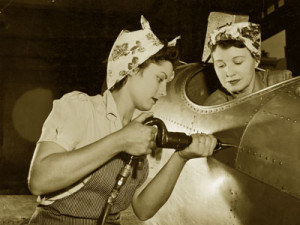
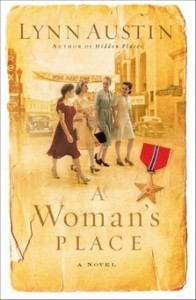 These real-life “Rosies” became the inspiration for my novel, A Woman’s Place. I interviewed dozens of them to find out what it was like to trade in their aprons for coveralls, and leave their kitchens to work a grueling, eight-hour shift in an armament factory. One of my characters, Jean, is based on a spunky woman from Texas, now in her nineties, who went on to realize her dream after the war, of earning a college education and becoming a pharmacist. She did it with her own earnings too, since Rosie didn’t enjoy the benefits of the G.I. Bill.
These real-life “Rosies” became the inspiration for my novel, A Woman’s Place. I interviewed dozens of them to find out what it was like to trade in their aprons for coveralls, and leave their kitchens to work a grueling, eight-hour shift in an armament factory. One of my characters, Jean, is based on a spunky woman from Texas, now in her nineties, who went on to realize her dream after the war, of earning a college education and becoming a pharmacist. She did it with her own earnings too, since Rosie didn’t enjoy the benefits of the G.I. Bill.
There wasn’t one individual “Rosie the Riveter,” there were more than six million of them. They were born shortly after that fateful Sunday, December 7, 1941 when the Japanese attacked Pearl Harbor. The United States declared war and life in America was changed forever. Husbands, fathers, brothers and sons marched off to fight, leaving the factories that produced airplanes, tanks, ships, and ammunition in dire need of manpower. The only available manpower was womanpower. In order to encourage women to join the workforce in war-time industries, the U.S. Government launched a campaign using the slogan, “We can do it.”
Norman Rockwell immortalized the image of a proud, self-confident Rosie wearing coveralls and holding a rivet gun on her lap. She appeared on the cover of the Saturday Evening Post on May 29, 1943. That same year, the song Rosie the Riveter by John Jacob Loeb became popular all across the country:
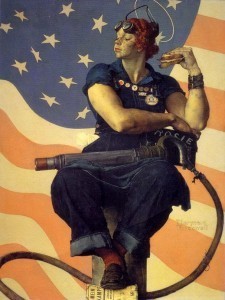 While other girls attend a favorite cocktail bar,
While other girls attend a favorite cocktail bar,
Sipping dry martinis and munching caviar;
There’s a girl who’s really putting them to shame—
Rosie is her name.
All the day long, whether rain or shine,
She’s part of the assembly line,
She’s making history, working for victory,
Rosie, Rosie, Rosie, Rosie, Rosie, Rosie the riveter.*
The statistics that America’s “Rosie the Riveters” accumulated during those war years don’t come close to describing the heroism of these women. By the war’s end they’d built nearly 300,000 airplanes, more than 100,000 tanks and guns, nearly 400,000 artillery pieces, 47 million tons of artillery ammunition, nearly 90,000 warships, and 44 billion rounds of small arms ammunition. There were casualties, too—thousands of women died or were injured in work-related accidents. They suffered from ridicule, discrimination, sexual harassment, and unequal pay. But they did what they had to do.
The most amazing thing to me is that they left home and went to work in an era where people honestly didn’t believe that women were capable of doing “men’s” work, physically or emotionally. Rosie proved them wrong. The August 1943 issue of Newsweek magazine reported: “They are in the shipyards, lumber mills, steel mills, foundries. They are welders, electricians, mechanics, and even boilermakers. They operate streetcars, buses, cranes and tractors.”* Women became police officers, taxicab drivers, farmers, and Civil Defense volunteers, watching the sky for enemy airplanes.
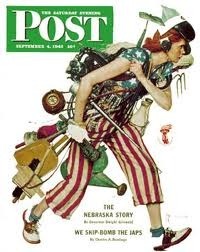 Many worked the midnight to 6:00 am shift then went home to take care of their children and households. There were no microwave ovens or pre-packaged dinners or fast-food take-outs back then. Meals had to be cooked from scratch. Laundry was an all-day task, with clotheslines instead of dryers and ironing boards instead of permanent-press. Norman Rockwell painted this portrait of a multi-tasking Rosie for the cover of Saturday Evening Post in September, 1943.
Many worked the midnight to 6:00 am shift then went home to take care of their children and households. There were no microwave ovens or pre-packaged dinners or fast-food take-outs back then. Meals had to be cooked from scratch. Laundry was an all-day task, with clotheslines instead of dryers and ironing boards instead of permanent-press. Norman Rockwell painted this portrait of a multi-tasking Rosie for the cover of Saturday Evening Post in September, 1943.
Rosie served out of patriotism. And when the war ended, she handed in her hard hat, collected her severance pay and went home so that the returning soldiers could have “their” jobs back. By then she had forever shattered all of the stereotypes about women’s work. Rosie proved that “We can do it” and left a lasting legacy. When I toured a modern-day shipyard to research A Woman’s Place, half of the workforce was made up of women.
 So, thank you Rosie the Riveter. You did much more that help build an arsenal and win a war. You opened the door for your daughters and granddaughters and great-granddaughters to pursue any career they could possibly dream of.
So, thank you Rosie the Riveter. You did much more that help build an arsenal and win a war. You opened the door for your daughters and granddaughters and great-granddaughters to pursue any career they could possibly dream of.
~Lynn
*from: Rosie the Riveter; Working Women on the Home Front in World War II by Penny Colman.
March 4, 2013
Dorothea Dix
 I’m so honored to be part of the amazing group of women writers. And I’m excited about introducing you to Dorothea Dix.
I’m so honored to be part of the amazing group of women writers. And I’m excited about introducing you to Dorothea Dix.
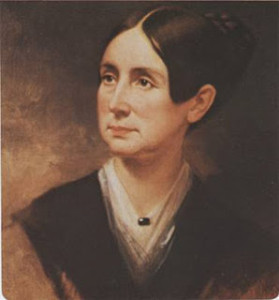
Dorothea Dix
As a Baby Boomer, I was fortunate to grow up in an era where girls were encouraged to pursue a college education. But when it came time to apply to colleges and choose a career, I discovered that most adults, including my high school guidance counselor, still believed that the only acceptable careers for women were as teachers or nurses. They made it seem as though I should be grateful for those two options!
My mother had become a registered nurse in the U.S. Navy during World War II—the first woman in our family to receive a higher education and have a career. Coming from humble, immigrant grandparents, she never would have had this opportunity if the war hadn’t created a critical need for nurses and provided scholarships. Here is a picture of Mom at age 19, proudly wearing her Navy Cadet uniform.

Mom at age 19,in her Navy Cadet uniform
It was an earlier war, the American Civil War, that first transformed nursing into a respectable career for women, thanks to the tireless work of Florence Nightingale, Clara Barton and Dorothea Dix. I learned about the first two women in school, but I came across Dorothea Dix while researching my Civil War novel, Fire by Night. The U.S. government appointed Miss Dix the Superintendent of Women Nurses in 1861 and she went to work with great diligence, studying the example of Florence Nightingale, to create a corps of dedicated women nurses. Her standards were very strict and included outstanding character. Preferring mature, married women, Dorothea wrote:
“No young ladies should be sent at all, but some who…are sober, earnest, self-sacrificing, and self-sustained; who can bear the presence of suffering and exercise entire self-control of speech and manner; who can be calm, gentle, quiet, active, and steadfast in duty. All nurses are required to be plain looking women. Their dresses must be brown or black, with no bows, no curls, no jewelry, and no hoop-skirts.”*
[image error]
“Fire by Night”
Julia Hoffman, the main character in my novel Fire by Night, butted heads with Miss Dix early in the story. Julia had decided to become a nurse to impress the man she had a crush on, but she didn’t meet Miss Dix’s qualifications. Julia was not only single, pretty, and quite spoiled, she exercised very little “self-control of speech and manner.” She did manage to remove her jewelry, pin her curly hair in a bun, and wear a brown dress to her interview with Dorothea Dix but she was turned down just the same. You’ll have to read Fire by Night to see if Julia managed to become a Civil War nurse in spite of all these obstacles.
Dorothea Dix’s story and her contribution to women’s history shouldn’t be forgotten. Born in 1802, “her early life was bleak, humiliating, and painful,”* yet she transformed her own pain into serving others. She first decided to become a teacher and opened a school in the barn behind her grandmother’s house to teach poor and neglected children. In 1841, while teaching a Sunday School class in a Massachusetts’ prison, she became aware of the terrible living conditions there, where the poor, the guilty, and the insane were all jammed in together to live in squalor. Miss Dix poured all of her compassion and energy into changing public opinion and lawmakers’ policies. The public’s outrage against such dreadful conditions resulted in improved prison conditions and a state-sponsored hospital for 200 mental patients.
This still wasn’t enough for Miss Dix. She visited state after state in her reform campaign for prisons and for the mentally ill, bringing much-needed change all across the country. Her work even spread to Canada and Europe, where she received an audience with Pope Pius IX. She was already famous and highly respected for her work when the Civil War broke out, and she bravely accepted the task of developing a corps of trained nurses to alleviate the pain and suffering of America’s wounded soldiers.
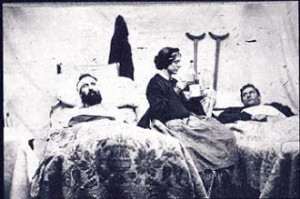
Nurse tending wounded soldiers
“In the latter days of Miss Dix’s career it may be said that no benevolent project ever lacked her support. . . . Work for others was still her mission and though she was loaded with praise and honor for the things she accomplished, she was as unostentatious as a child, and looked always for the results, and never at her own efforts.”*
Such humility is uncommon. Because she was driven by her compassion for all people, I think Dorothea would be only mildly interested to know that her work resulted in a huge stride forward for women, creating a career that is still highly respected today. What impresses me most about Dorothea Dix is that she refused to wallow in self-pity because of her difficult childhood. Instead, she transformed the hardships of her early life into a life’s work that benefitted millions of people. It’s an example I long to follow. How might the difficult times in my life be used by God for His kingdom and His glory?
That’s all for now,
Lynn
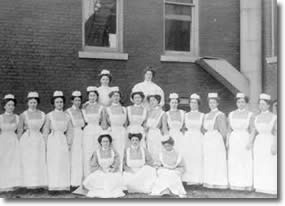
Civil War Nurses
*Our Army Nurses by Mary Gardner Holland.






